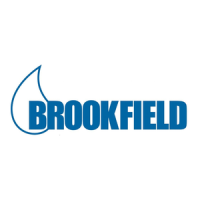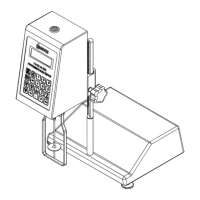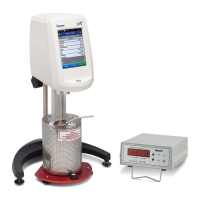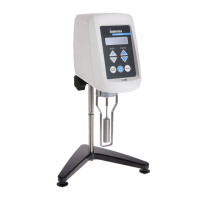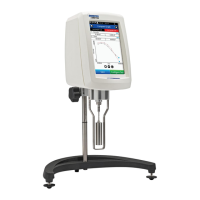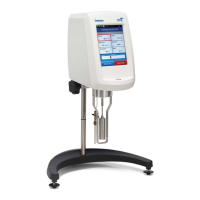Brookfield Engineering Laboratories, Inc. Page 23 Manual No. M/92-021-N0902
Cone Sample Volume
Part No.
CPE-40 0.5 ml
CPE-41 2.0 ml
CPE-42 1.0 ml
CPE-51 0.5 ml
CPE-52 0.5 ml
Table A6
Table A-1
4. Attach the sample cup to the Viscom-
eter and allow sufficient time for the
sample, cup and cone to reach tem-
perature equilibrium.
5. Turn the motor on. Set the desired
speed(s). Measure the viscosity and
record the reading in both % torque
and centipoise (cP).
NOTE: The cone spindle must rotate
at least five (5) times before a visco-
sity reading is taken.
6. Verify that the viscosity reading is
within the allowable 1% deviation, as
explained earlier, for the specific vis-
cosity standard fluid(s) that you are
using.
* The CPE designation on the cone
spindle indicates use with Electronic
Gap Setting Cone/Plate Viscometers/
Rheometers only.
A.4 VERIFYING CALIBRATION
1. Determine the appropriate sample volume.
Refer to Table A-1 to determine the correct
sample volume required for the spindle to be
utilized.
2. Select a Brookfield Viscosity Standard fluid
that will give viscosity readings between 10%
and 100% of full scale range. Refer to Ap-
pendix B for viscosity ranges of cone spindles;
ranges listed apply to CPE cones.
Do not use a silicone viscosity standard fluid
with a viscosity value greater than 5000 cP
with a Cone/Plate. Brookfield offers a com-
plete range of mineral oil viscosity standards
suitable for use with Cone/Plates for viscosi-
ties above 5,000 cP or shear rates above 500
sec
-1
; see Table E1 in Appendix E for a list of
available fluids.
It is best to use a viscosity standard fluid that
will be close to the maximum viscosity for a
given cone spindle/speed combination.
Example: LVDV-I+ Viscometer, Cone
Spindle CPE-42, Brookfield
Silicone Viscosity Standard
having a viscosity of 9.7 cP at
25°C.
At 60 RPM, the full scale viscosity range is
10.0 cP. Thus, the Viscometer reading should
be 97% torque and 9.7 cP viscosity ± 0.197
(closer to ±0.2) cP. The accuracy is a combi-
nation of Viscometer and fluid tolerance (re-
fer to Interpretation of Calibration Test
Results in Appendix E).
3. With the motor off, remove the sample cup
and place the viscosity standard fluid into the
cup.
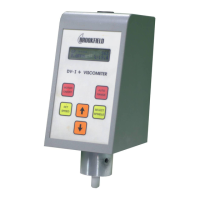
